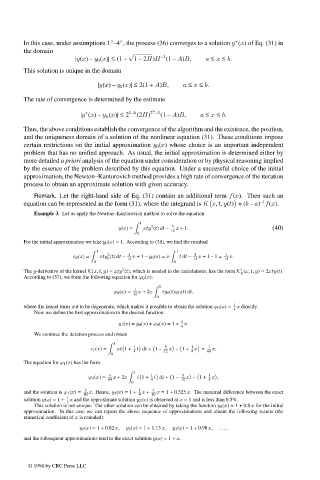Page 691 - Handbook Of Integral Equations
P. 691
◦
∗
In this case, under assumptions 1 –4 , the process (36) converges to a solution y (x) of Eq. (31) in
◦
the domain
√
–1
|y(x) – y 0 (x)|≤ (1 – 1 – 2H)H (1 – A)B, a ≤ x ≤ b.
This solution is unique in the domain
|y(x) – y 0 (x)|≤ 2(1 + A)B, a ≤ x ≤ b.
The rate of convergence is determined by the estimate
k
|y (x) – y k (x)|≤ 2 1–k (2H) 2 –1 (1 – A)B, a ≤ x ≤ b.
∗
Thus, the above conditions establish the convergence of the algorithm and the existence, the position,
and the uniqueness domain of a solution of the nonlinear equation (31). These conditions impose
certain restrictions on the initial approximation y 0 (x) whose choice is an important independent
problem that has no unified approach. As usual, the initial approximation is determined either by
more detailed a priori analysis of the equation under consideration or by physical reasoning implied
by the essence of the problem described by this equation. Under a successful choice of the initial
approximation, the Newton–Kantorovich method provides a high rate of convergence of the iteration
process to obtain an approximate solution with given accuracy.
Remark. Let the right-hand side of Eq. (31) contain an additional term f(x). Then such an
–1
equation can be represented in the form (31), where the integrand is K x, t, y(t) +(b – a) f(x).
Example 3. Let us apply the Newton–Kantorovich method to solve the equation
1
2
y(x)= xty (t) dt – 5 x +1. (40)
12
0
For the initial approximation we take y 0 (x) = 1. According to (38), we find the residual
1 1
2
ε 0 (x)= xty 0 (t) dt – 5 x +1 – y 0 (x)= x tdt – 5 x +1 – 1= 1 x.
12 12 12
0 0
2
The y-derivative of the kernel K(x, t, y)= xty (t), which is needed in the calculations, has the form K y (x, t, y)=2xty(t).
According to (37), we form the following equation for ϕ 0 (x):
1
ϕ 0 (x)= 1 x +2x ty 0 (t)ϕ 0 (t) dt,
12
0
where the kernel turns out to be degenerate, which makes it possible to obtain the solution ϕ 0 (x)= 1 4 x directly.
Nowwedefine the first approximation to the desired function:
y 1 (x)= y 0 (x)+ ϕ 0 (x)=1 + 1 x.
4
We continue the iteration process and obtain
1
1 5 1 1
ε 1 (x)= xt 1+ 4 t dt + 1 – 12 x – 1+ 4 x = 64 x.
0
The equation for ϕ 1 (x) has the form
1
ϕ 1 (x)= 1 x +2x t 1+ 1 t dt + 1 – 5 x – 1+ 1 x ,
64 4 12 4
0
and the solution is ϕ 1 (x)= 3 x. Hence, y 2 (x)=1 + 1 x + 3 x = 1 + 0.325 x. The maximal difference between the exact
40 4 40
solution y(x)=1 + 1 3 x and the approximate solution y 2 (x) is observed at x = 1 and is less than 0.5%.
This solution is not unique. The other solution can be obtained by taking the function y 0 (x) = 1 + 0.8 x for the initial
approximation. In this case we can repeat the above sequence of approximations and obtain the following results (the
numerical coefficient of x is rounded):
y 1 (x) = 1 + 0.82 x, y 2 (x) = 1 + 1.13 x, y 3 (x) = 1 + 0.98 x, ... ,
and the subsequent approximations tend to the exact solution y(x)=1 + x.
© 1998 by CRC Press LLC
© 1998 by CRC Press LLC
Page 674

